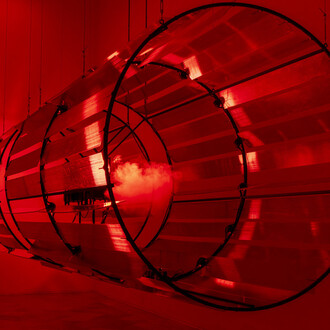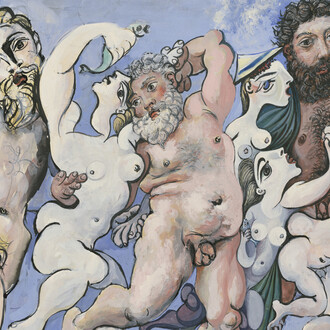“The meaning of art is: Learn to see and to feel life”, as affirmed in 1940 by Josef Albers, a German-born artist and professor living in the United States. For him, art is inseparable from life, and he encourages us “to open eyes.” This expression applies to both his conception of pedagogy and his artistic process.
This exhibition focuses on the way in which artists invite us to decentre our gaze and thereby transform our relationship to art, society and the world. Neither chronological nor narrative, the tour is shaped by visual, formal or thematic connections. It reveals affinities between works from various mediums, periods and contexts of creation, reflecting the wealth and diversity of the collections of the Musée National d’Art Moderne.
To open eyes is a free-flowing journey offering an open and non-exhaustive panorama of major movements and ruptures that have marked the history of art in the 20th and 21st centuries, through to recent creations reflecting contemporary issues. The works offer insights into our relationship with history and spirituality, the place of the body in art and society, but also on the way in which utopias shape our imaginaries.
Bodies / Colours
Majestic, fragmented, broken down or merely suggested, the human body is the focus of this section. Responding to Juliette Roche’s enigmatic painting, Judy Chicago’s video testifies to the earliest phases of eco-feminist thinking. The 1970s saw the development of feminist art: in the face of the hegemony of the “male gaze,” female artists (Joan Jonas, Friederike Pezold) reappropriated the image of their bodies and denounced their objectification in patriarchal society, while interrogating the mediums of performance, video and photography.
In the field of design, objects produced between the late 1950s and early 1980s testify to shifts underway in Western countries, marked by a new hedonism. Designers freed themselves from the precepts of modernism, which had made functionalism a central objective; they used new materials and organic forms to enrich the user’s sensory experience. Their experimentations were sometimes tinted with a critical aspect towards consumer society.
Icons / Signs
This first section features mainly abstract or conceptual works that challenge the very idea of an artwork and break with the aesthetics or dominant trends of their time. Josef Albers, Marcel Breuer, Paul Klee and László Moholy-Nagy all attended the Bauhaus in the first half of the 20th century. This experimental school of architecture and applied arts revolutionised the modern conception of art. Though produced in different periods and contexts, many works in this section present “minimal art-content” and engage the viewer in an active role. This is the case for Marcel Duchamp’s readymades, Piero Manzoni’s Merda d’artista and Robert Ryman’s monochrome triptych.
In the same tradition, Arte Povera artists such as Michelangelo Pistoletto made the banal and even the intangible the very material of their works. With Vera Molnár, the unfurling of graphic lines in space is a way to combine formal, aesthetic and poetic research, while Julie Mehretu reinvents pictorial abstraction by grounding it in current events.
Spiritualities / Syncretisms
The mysterious or spectral works presented in this section reflect a hybridisation between tradition and modernity. The blend of diverse references and sources of inspiration is a way for artists to convey a cultural, social and human history. Louise Nevelson develops a synthesis between primitivism and modern art, while Mathias Goeritz, inspired by pre-Columbian cultures, reaffirms the primacy of emotion in creation. Through a fertile dialogue between archaic and contemporary cultures, these artists build formal ties between periods, while renewing approaches to sculpture. In his works, Michael Heizer blurs the temporal borders between the prehistoric and industrial eras. For his part, Claes Oldenburg, a fervent advocate of bringing art and daily life closer together, transforms a drum kit into a ghostly, silent object. Beyond the Western antagonism between nature and culture, human and nonhuman, many artists draw on animist beliefs (Caroline Achaintre, Joseph Beuys, Myriam Mihindou), turning the artwork into a vehicle for transmission and the artist a conveyor, even a shaman.
Gestures / Imprints
Here, the body is addressed through the lens of gesture and performance. In the United States, the 1950s were marked by a predominance of Abstract Expressionism, a pictorial movement associated with the physical engagement of the artist, of which Jackson Pollock was one of the leaders. Many artists reacted to it by creating shifts. At that time, the works of Claire Falkenstein announced the arrival of “Eccentric Abstraction.” This trend brought together sculptures, often flat, made with non-traditional materials that abandoned the coldness of minimalism for a more sensual experience, often tinted with humour (Rosemarie Castoro). In their own way, the joyful and sensuous paintings of Huguette Caland act as a counterpoint to the imprints left by Yves Klein’s “living paintbrushes” (always women). Lastly, the engagement of the body reached its peak from the 1970s on, with performance practices and body art (Carolee Schneemann, Marina Abramović and Ulay, Sonia Andrade). Today, Alice Anderson is developing installation work in which the performative gesture is at the heart of the creative process.
Spaces / Revelations
The relationship between the work, the space and the viewer is a key concern of minimal art, the principles of which were theorised by Donald Judd: neutrality, objectivity and rejection of any form of expression. However, this desire to erase is paradoxical and the apparent simplicity of minimal works cannot escape the viewer’s subjectivity. Judd’s sculpture reveals a tension between interiority and exteriority, while Robert Smithson’s Mirror vortex offers an experience of diffracted space. The dialectic of inside and outside is found in Louise Bourgeois’ installation: though it seems closed, it is an open door to the artist’s inner world. Pierre Soulages’ deep black painting produces a sensation of impalpable immensity and invites to a meditative experience, while Simon Hantaï’s Tabula suggests an infinite expansion of the pictorial field. As for Haegue Yang, she is part of the aftermath of minimal art, but develops a more sensitive and narrative approach.
Fictions / Projections
Art has always echoed utopian desires and projections into an idealised future. This was the case in the 1960s, a period marked simultaneously by hedonism, technological innovation and the imagery of space conquest. At that time, design was marked by the pop wave (Pierre Paulin) and futurist aesthetics (Olivier Mourgue), while Kiki Kogelnik called her work “space art,” shifting between utopia and dystopia.
The International Group for Prospective Architecture, to which Paul Maymont and Nicolas Schöffer belonged, regarded architecture as a field of experimentation for rethinking our ways of inhabiting and living. In the same vein, Claude Parent and Paul Virilio proposed “living in the oblique” and Gordon Matta-Clark sought to change our perception of the urban environment.
To this day, science fiction is still seen as a tool to understand the world and remains a major source of inspiration for artists. While Caroline Mesquita’s sculptures stimulate our speculative imaginary, the ecosystems created by Mimosa Echard blur the lines between the organic and the technological.













![Saul Steinberg, The museum [El museo] (detalle), 1972. Cortesía del Museo de Arte Abstracto Español](http://media.meer.com/attachments/dfbad16c22c5940b5ce7463468ac8879f3b4bf23/store/fill/330/330/042ecf3bcd2c9b4db7ddbc57cb32e950c095835f7b5cd55b6e1576a6e78c/Saul-Steinberg-The-museum-El-museo-detalle-1972-Cortesia-del-Museo-de-Arte-Abstracto-Espanol.jpg)


